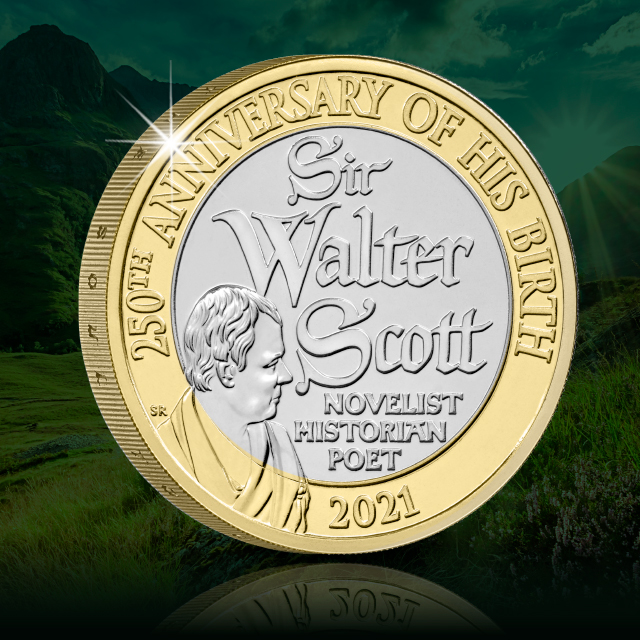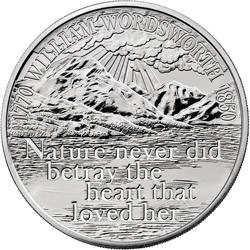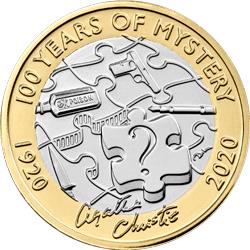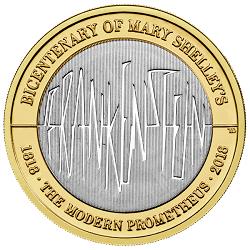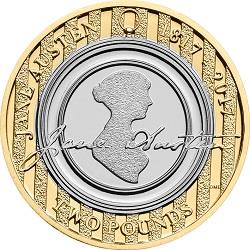£2 Coins
Official UK £2 coin celebrates 150 years of the FA Cup!
Can you work out the connection between these three events?
- In 2011, Yaya Toure’s 76th minute goal led Manchester City to seal their first major trophy in 35 years.
- The 1999 semi-final had one of the best solo goals in history, played between two of the biggest rivals in footballs.
- Arsenal beat Chelsea 2-0 in the 2002 final.
These are some of the very best moments in FA Cup History!
Producing hometown heroes, as underdogs play alongside Premier League giants, these unforgettable moments unite football fans, making the FA Cup one of the greatest knockout tournaments in the world.
The 150th Anniversary of the FA Cup 2022 £2 coin
In 2022, to celebrate a remarkable 150 years of the FA Cup, a UK £2 coin was issued featuring the famed FA Cup Trophy.
An absolute must-have for collectors and fans of the beautiful game alike, this is the perfect keepsake to commemorate such an incredible anniversary in football history.
This coin is no longer available from The Royal Mint, but you can still secure it in Brilliant Uncirculated Quality from Change Checker >>
With one of the largest fan-bases in the UK, football memorabilia is in high demand by collectors all over the world.
We’ve even seen huge popularity for Football themed coins in the past. Continue reading to find out our top UK coins that have celebrated this fantastic sport…
Olympic Football 50p

In 2012, the release of the Olympic 50p series kick-started a collecting frenzy across the nation.
It’s estimated that around 75% of these coins have been removed from circulation by collectors which means they are incredibly sought-after, especially considering these 50ps have some of the lowest mintage figures in circulation…
Many of the Olympic 50ps have a mintage less than 2,000,000 with the rarest being the Olympic Football 50p. This coin has a mintage of just 1,125,500!
It features a design of the hotly debated off-side rule, represented by a simple diagram. Designer Neil Wolfson, a sports journalist by trade, chose an image which he felt would encapsulate the sport whilst also provoke discussion.
Have you been lucky enough to find this sought-after coin in your collection? Let us know in the comments below!
1996 Football £2

Before 1997, £2 coins were struck from a single-coloured, nickel-brass and were mainly produced for collectors and reserved for very special occasions.
Between 1986 and 1996, only seven commemorative £2 coins were issued and this 1996 Football £2 was one of them.
The Euros of ’96 was such a significant occasion that The Royal Mint issued this coin “in celebration of football”.
The reverse design resembles a football, and is accentuated by the unusual concave surface of the coin. The year of 1996 is prominent on the design and the sixteen small rings represent the sixteen teams competing in the tournament. Only 5,141,350 were ever minted.
1996 saw England play host to the 10th European Football Championship and the eventual winners of the competition were Germany who knocked out the hosts in the semi-finals.
Do you remember seeing this £2 coin when it was first issued? Perhaps you even have it in your collection! Let us know in the comments below.
Secure the The 150th Anniversary of the FA Cup 2022 £2 coin for your collection!
‘Pioneer’ of the historical novel, Sir Walter Scott, commemorated on UK £2 coin…
Scottish novelist, poet, historian, and biographer, Sir Walter Scott, is often considered both the inventor and the greatest practitioner of the historical novel.
Sir Walter Scott’s early work consisted of poetic romances but his earlier books, set in Scotland, demonstrate his knowledge of Scottish history and society. His works were some of the most popular literary pieces of his time.
In the 250th anniversary year of his birth, The Royal Mint issued a £2 coin, commemorating him and his remarkable career.
2021 UK Sir Walter Scott £2
The coin, designed by Stephen Raw, features the text: “SIR WALTER SCOTT NOVELIST HISTORIAN POET” encircled by the inscription “250TH ANNIVERSARY OF HIS BIRTH” and the year date.
Excitingly, this coin also features the edge inscription, “THE WILL TO DO, THE SOUL TO DARE”, a quote from his epic poem, ‘Marmion: A Tale of Flodden Field’.
The 2021 Sir Walter Scott £2 was initially issued as part of the 2021 Annual Coin Set, but was later individually released. As well as in Brilliant Uncirculated quality, Change Checker also offered the Sir Walter Scott £2 in a limited edition display card, limited to just 4,995 worldwide!
Secure the Sir Walter Scott Display Card >>
Sir Walter Scott joins an impressive portfolio of authors, poets, novelists to be commemorated on UK coins. Continue reading to find out more…
2020 William Wordsworth £5
To mark the 250th anniversary of the birth of William Wordsworth, The Royal Mint issued this £5 coin and it was the first time that the famous poet was celebrated on a UK coin.
He is one of the most popular poets to have written in the English language, gaining popularity during the beginning of the English Romantic period in literature.
Designed by David Lawrence, designer of the 2018 and 2019 Britannia, the reverse features lines taken from one of Wordsworth’s most celebrated poems, ‘Tintern Abbey’.
2020 Agatha Christie £2
This £2 coin was issued in 2020 to mark the 100th anniversary of Dame Agatha Christie’s genre-defining murder mysteries.
An author of 66 detective novels and 150 short stories, Agatha Christie has justly earned the title of the ‘Queen of Crime’. Towards the end of her career, she was made a Dame of the British Empire for her contribution to literature.
The reverse design of this coin, by David Lawrence, depicts a jigsaw puzzle with a question mark, representing the mystery behind her stories.
2018 Mary Shelley’s Frankenstein £2
This £2 coin was issued by The Royal Mint to celebrate the 200th anniversary of the publication of Mary Shelley’s famous novel Frankenstein; or, The Modern Prometheus.
Whilst on holiday in Geneva Mary Shelley and her poet friends, including Lord Byron and future Husband Percy Shelley, decided to have a competition to see who could write the best horror story.
Out of this Mary Shelley created Frankenstein, a story about a scientist’s scary act at playing God and creating life. It went on to become one of the best loved gothic novels.
The reverse of this gothic coin was designed by Thomas Doherty and features the words ‘Frankenstein’ in an electric gothic font.
2017 Jane Austen £2
In 2017, to celebrate the life and works of one of Britain’s best-loved authors, The Royal Mint issued this Jane Austen £2.
Jane Austen is one of the best-loved English novelists from the 19th century. Her novels were revolutionary and from her first novel, Sense and Sensibility, readers began a love affair with her fiction that has lasted two centuries.
Designed by Dominique Evans, a portrait of Jane Austen features on the reverse of this coin. It did not enter general circulation and was issued in collector quality only.
2016 Shakespeare £2 coins

William Shakespeare is the most influential literary figure in British history and his works are an important part of Britain’s cultural heritage.
In 2016, a series of three £2 coins were issued to mark the 400th anniversary since his death and to celebrate his greatest works.
Each coin’s design takes inspiration from some of Shakespeare’s greatest works, including Macbeth (pictured central), A Midsummer Night’s Dream (far right) and his most-famous love tragedy, Romeo and Juliet (pictured left).
All three coins entered circulation but the Comedy £2 has the lowest circulating mintage – just 4,355,000!
2016 Beatrix Potter 50p
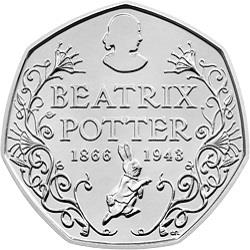
To celebrate the 150th anniversary of the birth of Beatrix Potter, the Royal Mint have released this 50p to celebrate Beatrix herself.
Designed by Emma Noble, the coin includes elements that celebrate Beatrix as the artist behind some of the best-loved characters in children’s literature along with the nostalgic font used for the inscription.
This coin entered general circulation and has a mintage of 6,900,000.
Secure the 2021 UK Sir Walter Scott £2 for your collection!
Secure the 2021 UK Sir Walter Scott £2 in Brilliant Uncirculated quality >>
‘The Father of Science Fiction’, H. G. Wells, is celebrated on a UK £2 coin…
In the late 1800s, Herbert George Wells created a new breed of novel, pioneering the genre that would later be defined as science fiction.
His creative and forward-thinking novels provide a window to the future and have become famous all over the world, with his audience spanning across generations.
In the year marking the 75th anniversary of his death, a UK £2 coin was issued, featuring a design which pays a fitting tribute to his famous novels, Time Machine, The Invisible Man, and War of the Worlds.
2021 UK H. G. Wells £2
Chris Costello’s design on the coin takes inspiration from these world-famous novels, with a depiction of the Invisible Man and a Martian encircled by clock numerals.
The 2021 H. G. Wells £2 is no longer available from The Royal Mint, but you can still secure it in Brilliant Uncirculated Quality from Change Checker >>
Have you ever seen a four-legged tripod?
Arguably one of the most controversial and talked about coin designs of 2021, the H. G. Wells £2 paid tribute to the Father of Science-Fiction’s best known works and includes a design featuring the Invisible Man as well as a four-legged ‘tripod’.

This unusual design hit the headlines when eagle-eyed collectors picked up on the additional leg featured on the Martian from Well’s famed War of the Worlds when the coin was originally issued in the 2021 Annual Coin Set.
H.G. Wells £2 – Blank ‘Error’

The coin hit the headlines once more for another reason, after another supposed ‘error’ was spotted on the version issued as part of the 2021 Annual Coin Set.
With the clue in the name, a bi-metallic coin is usually made up of a combination of a silver coloured cupro-nickel disc and an outer yellow nickel-brass ring. However, in the case of this H.G. Wells £2 coin, it appears that the blank used has a thicker yellow ring, much wider than what we’d see on normal £2 coins.
When striking £2 coins, the first step is to punch a hole through a blank planchet to create the outer section. The inner core is taken from a different metal, sized to fit inside the outer ring.
There have been estimations that if this coin was to be sold at auction, it could fetch over £1,000! Errors and mis-strikes like this certainly makes for interesting collecting!
The Father of Science Fiction
After the publication of his first novel, The Time Machine, in 1895, H. G. Wells became an overnight sensation. He began to write a series of science fiction novels that would define him as a truly original writer.
The War of the Worlds (1898) and The Invisible Man (1897) joined The Time Machine as H. G. Wells most celebrated and well-known novels .
Wells was described by his contemporaries as undeviating and fearless in his efforts for social equality, world peace, and what he considered to be the future good of humanity.
Add the 2021 UK H. G. Wells £2 to your collection today!
The 2021 UK H. G. Wells £2 is no longer available from The Royal Mint, but you can still secure it in Brilliant Uncirculated quality from Change Checker >>
This coin was even issued in a limited edition display card, limited to just 4,995 worldwide! Secure yours >>



